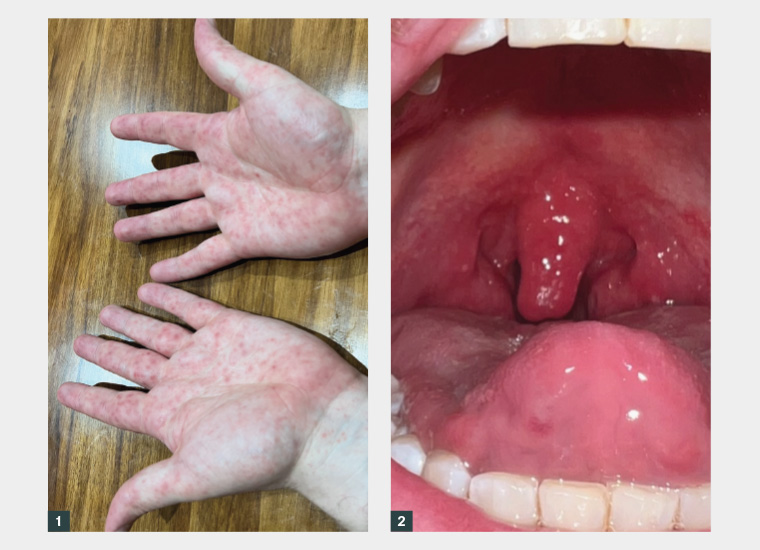Case
A man, aged 31 years, presented with a five-day history of worsening sore throat and a mixed macular–vesicular rash on his hands. He also reported the sensation of occasional ‘pins and needles’ in his feet. The illness began with a sore throat that got progressively worse over 48 hours. Over the following days, he developed macular lesions on the hands that became vesicular (Figure 1). On examination of the mouth and throat, an oedematous uvula was seen with small ulcers on the pharynx (Figure 2). He had ‘severe’ pain on swallowing and was unable to tolerate food due to pain. He reported to have no other medical history or regular medications. His son had recently been unwell with hand, foot and mouth disease and he stated, ‘It can’t be that, only kids get that infection’. Interestingly, on further history, he stated he did not go childcare when he was young and his mother could not recall him ever having hand, foot and mouth disease.

Figure 1. Mixed macular and vesicular hand lesions.
Figure 2. Oedematous uvula and pharyngeal ulcers.
Question 1
What is the most likely diagnosis?
Question 2
What are the differential diagnoses?
Question 3
How does the diagnosed condition typically present?
Question 4
Are any investigations required?
Question 5
How is the condition managed?
Answer 1
The most likely diagnosis is hand, foot and mouth disease.
Answer 2
Common differentials are presented in Table 1.
| Table 1. Common differential diagnoses for hand, foot and mouth disease1 |
| Condition |
Pathogenesis |
Presentation |
| Aphthous ulcers |
Unknown |
- Shallow, round, painful ulcers up to 1 cm in size with surrounding erythema
|
| Herpangina |
Coxsackievirus, echovirus |
- Oral vesicles that then form ulcers
- This is thought to be on a continuum with hand, foot and mouth disease
|
| Herpetic gingivostomatitis |
Herpes simplex virus 1 and 2 |
- Fever, oral erythema, small oval vesicles on the palate, tongue and oral mucosa that become confluent
|
| Measles |
Measles virus |
- Fever, cough, coryza and Koplik spots (white papules) on the oral mucosa
- A macular rash often starts on the head and spreads distally
|
| Varicella (chickenpox) |
Varicella zoster virus |
- Generalised itchy and vesicular rash
- The rash starts on the face and trunk, then spreads to the rest of the body
- Often macules appear before vesicular lesions form
|
Answer 3
Hand, foot and mouth disease is a highly contagious viral infection that primarily affects children under the age of five years. However, cases have also been reported in adults.1,2 Hand, foot and mouth disease is caused by enteroviruses, most commonly coxsackievirus A16 and enterovirus 71.3 Hand, foot and mouth disease typically presents with symptoms such as fever, sore throat and a characteristic rash on the hands, feet and mouth. The rash can be macular, papular or vesicular in nature and lesions might also be present on the buttocks and genitals.4 In adults, the manifestation of hand, foot and mouth disease often presents with milder symptoms and a lower risk of complications compared with children. It is estimated that fewer than 1% of adults display clinical manifestations of the disease.2 The exact reasons why hand, foot and mouth disease affects adults less severely than children are not fully understood. However, it is believed that adults might have some level of immunity from previous exposure to enteroviruses, which can provide some protection against the disease.2 This case is interesting in that an adult with potentially no or minimal previous exposure developed significant features of the disease.
Answer 4
Diagnosis is usually based on clinical presentation.4 In some cases, laboratory testing (throat swabs or stool polymerase chain reaction) might be done to confirm the presence of the enterovirus, though this is rarely done. Healthcare professionals need to be aware of the possibility of hand, foot and mouth disease in adults and consider it as a differential diagnosis, especially if there is a history of exposure to infected individuals or if the patient presents with the characteristic symptoms.
Answer 5
Management of hand, foot and mouth disease in adults is similar to that in children. Adults with hand, foot and mouth disease should focus on relieving symptoms and preventing the spread of the virus. This can be done by practising good hygiene, such as regularly washing hands with soap and water, using hand sanitisers and avoiding close contact with others who might be susceptible to the virus.5 In Australia, children are excluded from childcare or school until all blisters have dried.6 By this measure, adults should not attend work until their blisters have dried. It is important patients understand the virus is shed in the faeces for several weeks after all lesions have crusted, and diligent hand hygiene should be maintained to prevent further spread of infection.6 There is no specific treatment for hand, foot and mouth disease in adults because it is a self-limiting condition that resolves on its own within 7–10 days. It is interesting to note topical lidocaine is not recommended for mouth and throat pain.7
Key points
- It is estimated that fewer than 1% of adults display clinical manifestations of hand, foot and mouth disease.
- Diagnosis is usually based on clinical presentation.
- Management of hand, foot and mouth disease in adults is similar to that in children.